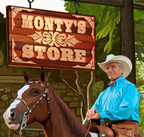I have a question - I have an 8yo IDxTB who has always struggled with moving forward (a reflection on me I know), but I now want to make the change. So having watched the lesson I am fired up to re-establish my cues for walk in line with Monty's, but I have a feeling that if I pick up the reins and squeeze gentle with my legs, with a slight lean forward nothing will happen. So the question is what do I do next? Do I re-ask the question in the same way until I get some movement and then take the legs off? Or do I bring some other stimulus in to get the movement and then remove the cues? Any advice/ comments gratefully received.
Rewards
Subscribe to Equus Online University and become a part of Monty's worldwide mission to leave the world a better place for horses and for people too.
Students automatically gain access to special rewards, such as exclusive discounts at the Monty Roberts Online Shop. Visit Monty Roberts Online Shop.




get someone to help you from the ground, they can help by gently asking for forward at the same time, also they have a good view of the actual signals you're giving, not to mention taking some of the pressure off of you.
Thanks spdltd sounds like a good plan, to have someone to help both him to move forward and me to sit still. I will try to rope in a willing volunteer and let you know how I get on.
Also, something slightly more thought provoking....when watching the lead changes lesson I noted that Monty's horse switched front legs first and then its back legs - where as Charlotte's horse switched back legs and then front legs in the moment of suspension between the strides. In the dressage world I believe that for Monty's horse it would be referred to as 'late behind' on the change. I think the method Monty used to introduce the changes was fantastic but how do you make the transition from the 'late behind' version to the classic flying change? (ps I have no idea how to do this!!!)
Basic rule (in English dressage) is that you do not want the horse to be 'late behind', or put in half a step in walk or trot before the change, to begin with, because it is a habit very hard to break.
You just can't go from that to flying changes - it would be like taking the wrong turn in the road and then try to hike back through a deep forest. You just have to go back and start over.
-
As for how to do it, authors have written entire chapters on that, but simply put - very, VERY simply put! - you work with the canter and counter canter until the horse is strong and stable enough to be straight in a collected canter. Then you practice transitions with a few steps of walk in between the lead changes, decreasing the number of steps over time until the horse understands what you want.
-
There are of course lots of variations and ways to go about it; Monty's way, circle back and change, change over a pole on the ground, etc. etc.
Also, the flying change for show jumpers (for example)is different from the one preferred in dressage tests.
I think the real trick is to find the way that will suit your horse the best.
Food for thought - but I understand what you say about taking the wrong turn. I certainly need to work more on the canter and counter canter and response from my leg before I try anything. Time to put my thinking cap on and try to figure out how to cause the horse to want to do the right move.
So much to teach the horse and so little time!!
also, the western horse don't have as much collection in their frame and don't come as 'over the back' as the dressage horses - so the changes won't be as together. Getting a nicely compacted or collected canter will help to keep the changes from falling late behind too! getting them to sit up in front and carry themselves will go along way to improving the changes!
Ahh yes, seems obvious now you say that but didn't notice (so have now re-watched the lesson!). Counter canter is coming on and becomming more established and horse more flexible. Interestingly I was in the sandschool last night when some other horses came in a started whizzing around. My boy got a bit excited and as I was trying to canter a right hand circle he started to cut in a bit so I put some more inside leg on to keep him out and we did a flying change!!
Didn't try to repeat it (as it was all a bit tense because of the other horses) but just shows it works - and I will save it for another day when we can practise calmly.
Will practise some more on the 'up hill' movement but will be ready to start trying changes soon. Very excited - and trying to be patient and establish all the building blocks first.